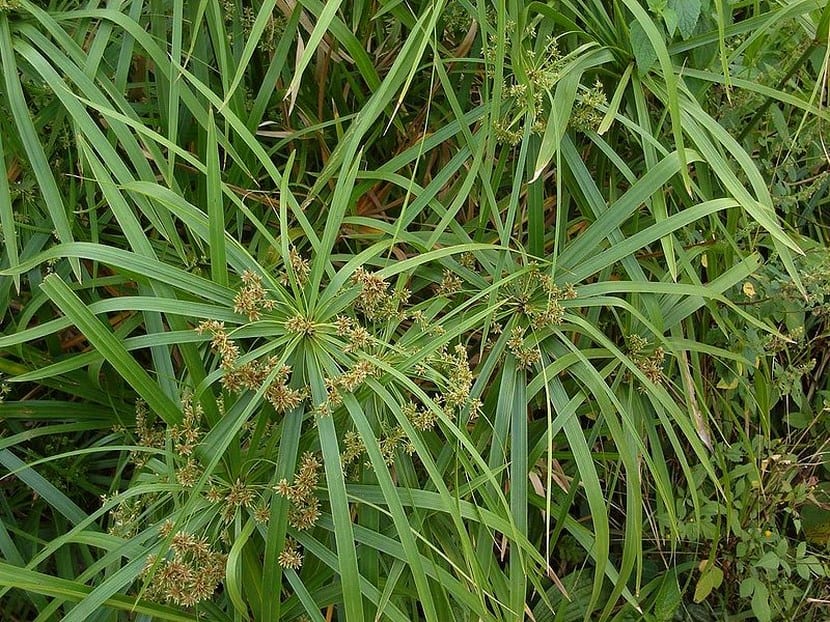
When there is space in the house, there is nothing more beautiful than having a pond. These water mirrors create a unique corner in the garden, especially when surrounded by abundant vegetation.
If you are looking for an pond edge plants, can you think of the call False Papyrus, a grassy plant which is ideal in these cases due to its morphology.
Knowing the false papyrus

The scientific name of the false Papyrus is Cyperus alternifolius-involucratus and it is a plant that belongs to the family Cyperaceae, a genus to which more than 600 species belong, being the Papyri the best known.
Papyrus grows naturally in humid places in many parts of the world and that is why this variety adapts very well to the edges of ponds.
In the case of the false papyrus, the plant is native to Madagascar and is a perennial species It occurs in clumps and has long, thin leaves with long petioles. The leaves are the main attraction of the plant because the flowers are small, white and not very showy.
Plant care

El fake papyrus it adapts very well to all types of soils, even those that are too humid or with puddles, another reason why the plant is ideal to live next to ponds and other water bodies. It also adapts very well to different climates although it does not tolerate frosts, especially if they are very intense.
Ideally, the plant is in partial shade although it can resist sun exposure.
If you want to grow the false papyrus you can do it directly in the ground or in pots, although in these cases it is best to place a plate under the pot so that the plant has water available at all times. If you decide to plant it in the ground, you can do it next to a water mirror or submerged in it.
Hello, I have Egyptian papyri, last summer and two ago they were the star in my garden, but this summer they do not grow, they look dry without lack of water .. In the two places where I planted them it has happened the same, and in the nursery where I bought them tb the same thing has happened. It must be a pest or disease that we miss. But they are not the false papyri of which you speak. If not the actual Egyptian papyrus. Please I need help as I watch him die.
Hello Bernardo.
Have you by chance had frosts? The papyrus (Cyperus papyrus) resists the weak ones well, but if a year they last longer than normal or are more intense, they can harm it.
Another possibility is that they are running low on compost. It is recommended to pay them with a liquid fertilizer for green plants, putting half the indicated dose.
Thank you very much for the reply. I doubt that the reason is the frosts, since I live in an area of the Murcia region where frosts are not frequent. And I have two papyri, one of them that was the one that was splendid the previous year, I come to summer already strange, but the other was in the middle of summer when it began to look ugly. Fertilizer, they receive the same from some fruit trees that are watered by drip and in summer the water is abundant. It is not specific for green plants, I will try .. But it gives the sensation of some plague, since the papyri, or they come out dry from the stem, or they do not open at the top or they open very little and there is practically not one left. Do you know possible options for pests that may affect it? It is an area with a lot of vegetation and I always have to be spraying something. Thanks for everything!
Hello again Bernardo.
The only pest that can really affect you are mealybugs (both the cottony one and the one known as Piojo de San José).
It occurs to me that they may be having excess water. Papyrus plants are riverside plants, and although they need high humidity, they do not want to be permanently flooded like water lilies for example.
Thus, if you can somehow avoid not getting as much water, they will surely start to look better. If you have them in a pot, mix the substrate with a little (10-15%) of perlite or volcanic clay to improve drainage.
A greeting.
Hello, I have a fake papyrus and for a long time practically nothing grows, the few shoots that come out are very weak and pale, what can I do?
Thank you
Hello Chelo.
How often do you water it? It needs frequent water, as it is a semi-aquatic plant.
If it has been in the same pot for a long time, I recommend moving it to one that is about 4cm wider. So you can continue to grow.
You can also pay it with a universal fertilizer following the instructions specified on the package.
A greeting.